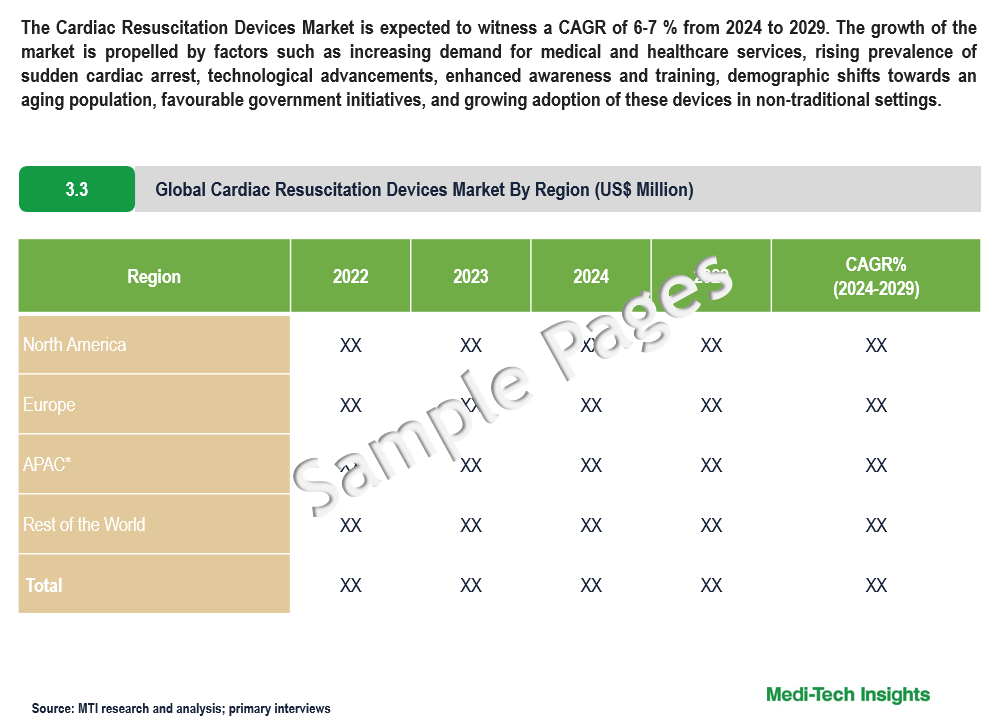
Cardiac Resuscitation Devices Market Size, Share, Growth for 2024 to 2029: Shaping the Future of Emergency Care
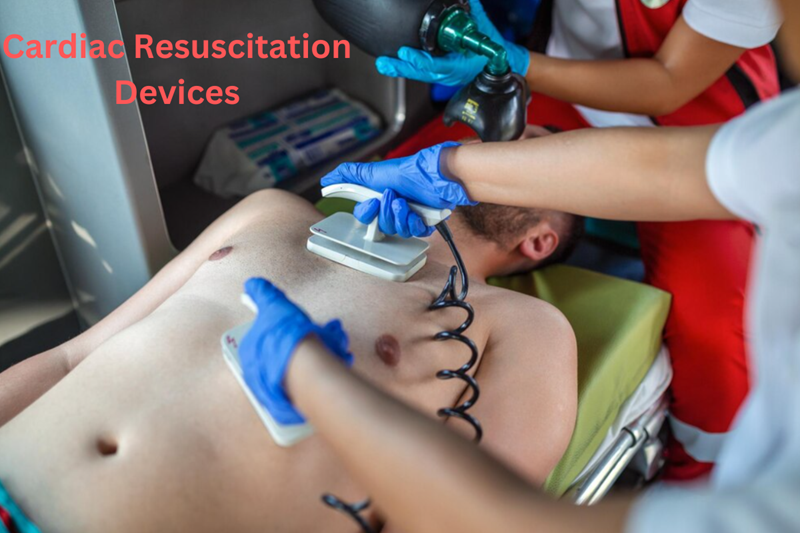
The Cardiac Resuscitation Devices Market is expected to witness a CAGR of 6-7 % from 2024 to 2029. The growth of the Cardiopulmonary Resuscitation (CPR) Devices market is propelled by factors such as increasing demand for medical and healthcare services, rising prevalence of sudden cardiac arrest, technological advancements, enhanced awareness and training, demographic shifts towards an aging population, favourable government initiatives, and growing adoption of these devices in non-traditional settings. To learn more about the research report, download a sample report.
Cardiac resuscitation, also known as cardiopulmonary resuscitation (CPR), is an emergency procedure performed on individuals experiencing cardiac arrest, a condition where the heart suddenly stops beating effectively. CPR involves a combination of chest compressions and rescue breaths to maintain blood flow and oxygenation to vital organs, particularly the brain until advanced medical help arrives. The main goals of CPR are to sustain circulation and oxygenation until the heart can be restarted or until more advanced medical interventions, such as defibrillation, can be administered.
Cardiac resuscitation devices are tools designed to assist in the performance of CPR or to provide additional support during resuscitation efforts. Some common cardiac resuscitation devices include:
- Automated External Defibrillators (AEDs): These portable devices analyze the heart rhythm and deliver an electric shock if necessary to restore normal heart rhythm. AEDs are commonly used in conjunction with CPR
- Mechanical CPR Devices: These devices provide automated chest compressions during CPR. They can ensure consistent and effective chest compressions, especially in challenging situations such as during transport or in confined spaces
- Airways and Oxygen Delivery Devices: Devices such as bag-valve masks and advanced airway adjuncts help maintain an open airway and provide oxygenation during CPR
- Chest Compression Assist Devices: These devices assist rescuers in delivering chest compressions by providing feedback on compression depth and rate, ensuring optimal performance
- Extracorporeal Membrane Oxygenation (ECMO) Machines: In more advanced cases of cardiac arrest, ECMO machines can temporarily take over the function of the heart and lungs, providing oxygenated blood to the body while efforts are made to restore normal heart function
These devices play a crucial role in improving the effectiveness of CPR and increasing the chances of survival for individuals experiencing cardiac arrest. Proper training in the use of these devices is essential for healthcare professionals and bystanders who may need to perform CPR in emergencies.
Market Momentum: Understanding the Forces Propelling CPR Devices Growth
Apart from the increasing medical and healthcare needs and the growing prevalence of chronic diseases, various factors are propelling the expansion of the Cardiopulmonary Resuscitation (CPR) Devices market. Continuous innovation in CPR device technologies, including the development of portable and automated devices, is enhancing the accessibility and effectiveness of CPR, thereby fostering market expansion. The growing public awareness about CPR and the significance of early intervention in cardiac emergencies, coupled with widespread CPR training initiatives, are driving an increased demand for CPR devices. For instance,
- In April 2023, Defibtech unveiled the ARM XR, the latest advancement in their automated CPR device lineup, designed for emergency medical professionals to aid patients in cardiac arrest, aiming to broaden the utilization of automated CPR technology among emergency responders and enhance outcomes for out-of-hospital cardiac arrest cases
The aging population, being more susceptible to cardiac-related conditions, constitutes another factor contributing to the heightened demand for CPR devices. Moreover, government initiatives and regulations mandating CPR device availability in public spaces further drive market growth. The escalating healthcare expenditure, particularly in developing countries, is fueling investments in emergency medical equipment, including CPR devices, thereby boosting the market. The growing adoption of CPR devices in non-traditional settings, such as home care, sports facilities, and public transportation, is expanding the market beyond traditional healthcare settings. Lastly, the high global incidence of sudden cardiac arrests is driving demand for CPR devices, given that prompt intervention with CPR significantly improves survival rates. Overall, these factors collectively drive the growth and expansion of the Cardiopulmonary Resuscitation Devices market.
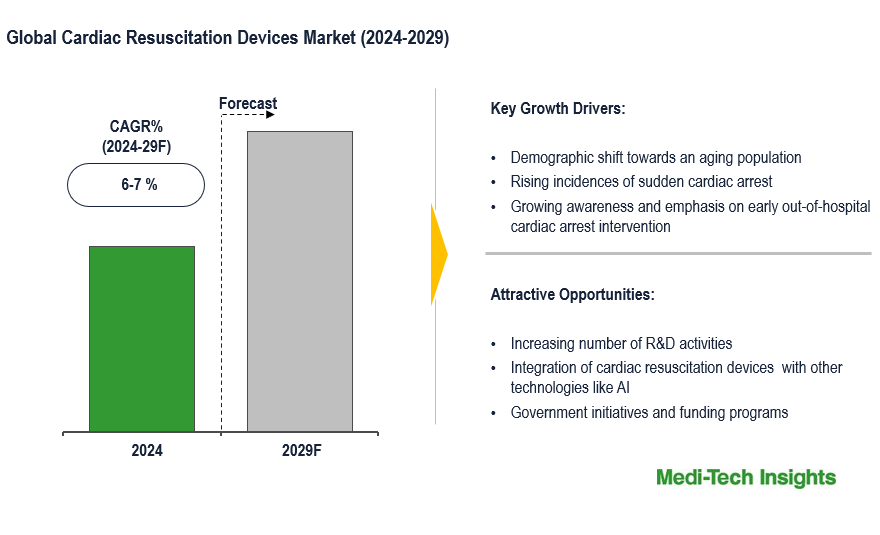
To learn more about this report, download the PDF brochure
From Wearable Tech to AI: Advancements in Cardiac Resuscitation Devices
Cardiac resuscitation devices are indispensable in saving lives during sudden cardiac arrest (SCA) by providing prompt treatment to restore heartbeat and circulation. Additionally, wearable cardiac resuscitation devices offer continuous monitoring and immediate response capabilities, automatically administering shocks to restore normal heart rhythm as needed. Telemedicine and remote assistance platforms empower experts to guide personnel in CPR techniques, particularly in areas with limited healthcare access. Modern devices also feature real-time feedback for CPR techniques, integrating with telemedicine for remote monitoring and guidance during emergencies. For instance,
- In January 2023, Mindray unveiled the next-generation BeneHeart series defibrillators, the BeneHeart D60 and D30, with a focus on elevating resuscitation standards through enhanced reliability, expert diagnosis and monitoring tools, and a comprehensive quality improvement solution for both in-hospital and pre-hospital-rescue-scenarios
Integration of artificial intelligence (AI) and machine learning (ML) has revolutionized CPR training and assistance, providing instant feedback on CPR quality. Enhanced data collection and analysis capabilities aid healthcare providers in evaluating care quality and refining resuscitation protocols. Miniaturization has led to the development of wearable CPR devices, ensuring continuous monitoring and automatic CPR initiation when necessary. The advancements in the Cardiopulmonary Resuscitation Market signify a significant evolution, enhancing CPR accessibility, efficiency, and effectiveness. Collaborative efforts between medical professionals, researchers, and manufacturers are driving ongoing progress in cardiac resuscitation technology, aiming to improve outcomes for sudden cardiac arrest patients amidst the increasing prevalence of cardiovascular diseases and sudden cardiac arrests.
Key Constraints/Challenges
One of the significant challenges associated with the cardiac resuscitation devices market is ensuring widespread accessibility and proper training in the use of these devices. Despite advancements in technology and increased awareness of CPR techniques, there remains a gap in access to cardiac resuscitation devices, particularly in rural or underserved areas. Additionally, ensuring adequate training for healthcare professionals and laypersons in using these devices effectively poses a challenge. Moreover, regulatory complexities and varying standards across different regions can hinder the seamless adoption and deployment of cardiac resuscitation devices. Furthermore, the high cost associated with acquiring and maintaining these devices may limit their accessibility, particularly in resource-constrained settings.
Regional Dynamics in the Cardiac Resuscitation Devices Market: Analyzing Geographic Trends
Analyzing regional segmentation helps stakeholders tailor their strategies to specific market conditions and target audiences, thereby maximizing growth potential and addressing regional needs effectively. The regions covered in the Cardiac Resuscitation Devices market include North America, Europe, Asia Pacific, Latin America, and the Middle East and Africa. North America is expected to hold a significant share of the market owing to its robust healthcare infrastructure, high awareness of CPR techniques, and stringent regulatory standards, driving the adoption of advanced cardiac resuscitation technologies.
Additionally, factors such as a growing aging population and increasing incidences of cardiac arrests contribute to the demand for innovative CPR devices. Conversely, in the Asia Pacific region, including countries like China, Japan, and India, the market landscape is influenced by rapid urbanization, increasing healthcare expenditure, and rising prevalence of cardiovascular diseases, presenting significant growth opportunities for Cardiac Resuscitation Devices. The region also witnesses the emergence of telemedicine and mobile health technologies, which further drive the adoption of CPR devices.
Competitive Landscape
Key players in the Cardiac Resuscitation Devices market include Medtronic plc, Stryker Corporation, Koninklijke Philips N.V., Physio-Control, ZOLL Medical Corporation, Dragerwerk AG & Co. KGAa, Cardinal Health, Nihon Kohden, ResMed Inc., Mindray Medical, and GE Healthcare among others.
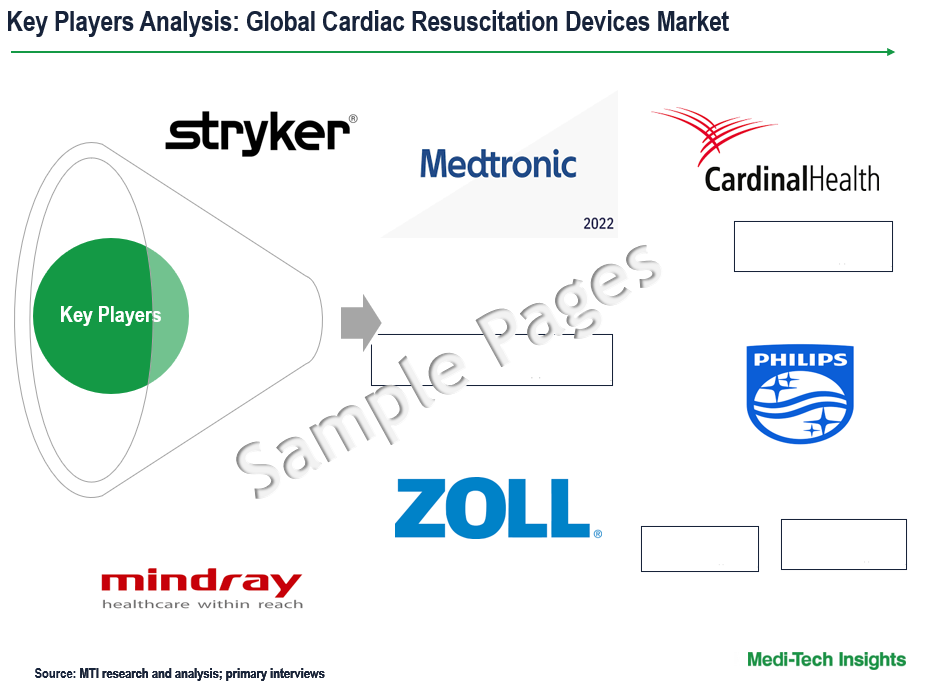
Get a Sample Report for Competitive Landscape Analysis
Organic and Inorganic Growth Strategies Adopted by Players to Establish Their Foothold in the Market
Players operating in this market are adopting both organic and inorganic growth strategies such as collaborations, and acquisitions to garner market share. For instance,
- In April 2023, Nordic Capital acquired a majority share in Corpuls to bolster the company's next growth phase, Corpuls specializes in emergency medical solutions and cardiac resuscitation, particularly in the external defibrillator segment, and is recognized as one of Germany's fastest-growing mid-market companies, attributed to its innovative product portfolio and strong research and development capabilities
- In March 2022, Avive Solutions, Inc., a developer of an intelligent AED and connected response platform for out-of-hospital cardiac arrest (OHCA) emergencies, announced the closure of a $22 million Series A round of financing, co-led by Questa Capital, Catalyst Health Ventures, and repeat investor Laerdal Million Lives Fund
- In September 2021, Cardio Partners expanded its national presence by acquiring Allied 100, LLC, thereby broadening their range of emergency preparedness products and services.
The Cardiac Resuscitation Devices Market is expected to gain momentum in the coming years due to the rising prevalence of sudden cardiac arrest, growing awareness and training programs, rising research and development activities, technological advancements, strategic collaborations and aggressive organic and inorganic growth strategies followed by the players.
Key Strategic Questions Addressed
-
What is the market size & forecast for the Global Cardiac Resuscitation Devices Market?
-
What are the historical, present, and forecasted market shares and growth rates of various segments and sub-segments of the Global Cardiac Resuscitation Devices Market?
-
How has COVID-19 impacted the Global Cardiac Resuscitation Devices Market?
-
What are the major growth drivers, restraints/challenges impacting the market?
-
What are the opportunities prevailing in the market?
-
What is the investment landscape?
-
Which region has the highest share in the global market? Which region is expected to witness the highest growth rate in the next 5 years?
-
Who are the major players operating in the market? What is the competitive positioning of key players?
-
Who are the new players entering the market?
-
What are the key strategies adopted by players?
- Research Methodology
- Secondary Research
- Primary Research
- Market Estimation
- Market Forecasting
- Executive Summary
- Market Overview
- Market Dynamics
- Drivers
- Restraints
- Opportunities
- Market Dynamics
- Global Cardiac Resuscitation Devices Market - Size & Forecast (2021-2028), By Product Type
- Airway Management Devices
- External Defibrillators
- Other Products
- Global Cardiac Resuscitation Devices Market - Size & Forecast (2021-2028), By Patient Type
- Adult Patient
- Paediatric Patient
- Global Cardiac Resuscitation Devices Market - Size & Forecast (2021-2028), By End User
- Hospital
- Ambulatory Surgical Centers
- Cardiac Centers
- Pre-Hospital Care Settings
- Other End Users
- Global Cardiac Resuscitation Devices Market - Size & Forecast (2021-2028), By Region
- North America (U.S. & Canada)
- Europe (UK, Germany, France, Italy, Spain, Rest of Europe)
- Asia Pacific (China, India, Japan, Rest of Asia Pacific)
- Rest of the World (Latin America, Middle East & Africa)
- Competitive Landscape
- Key Players and their Competitive Positioning
- Competitive Positioning of Key Players (2022)
- Offerings Assessment, By Players
- Key Strategies Assessment, By Player (2021-2023)
- New Product Launches
- Partnerships, Agreements, & Collaborations
- Mergers & Acquisitions
- Other Developments
- Key Players and their Competitive Positioning
- Key Companies Scanned (Indicative List)
- Medtronic Plc
- Stryker Corporation
- Koninklijke Philips N.V.
- Physio-Control
- ZOLL Medical Corporation
- Dragerwerk AG & Co. KGAa
- Cardinal Health
- Nihon Kohden
- ResMed Inc.
- Mindray Medical
- GE Healthcare
- Other Players
The study has been compiled based on extensive primary and secondary research.
Secondary Research (Indicative List)

Primary Research
To validate research findings (market size & forecasts, market segmentation, market dynamics, competitive landscape, key industry trends, etc.), extensive primary interviews were conducted with both supply and demand-side stakeholders.
Supply Side Stakeholders:
- Senior Management Level: CEOs, Presidents, Vice-Presidents, Directors, Chief Technology Officers, Chief Commercial Officers
- Mid-Management Level: Product Managers, Sales Managers, Brand Managers, Business Development Managers, Consultants
Demand Side Stakeholders:
- Stakeholders in Hospitals, Ambulatory Surgical Centers, Cardiac Centers and Pre-Hospital Care Settings among others
Breakdown of Primary Interviews
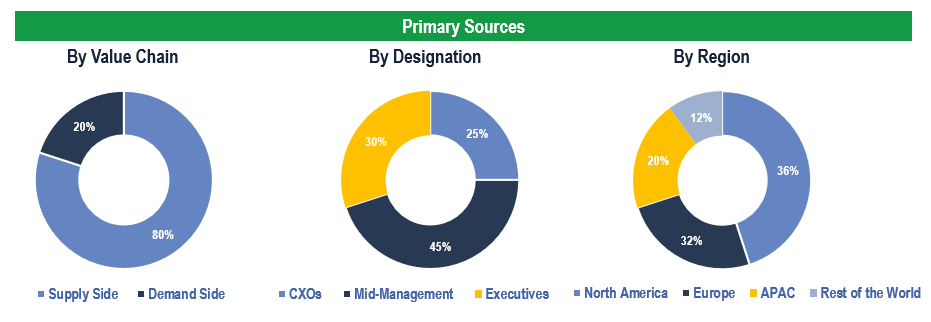
Market Size Estimation
Both ‘Top-Down and Bottom-Up Approaches’ were used to derive market size estimates and forecasts.
Data Triangulation
Research findings derived through secondary sources & internal analysis were validated with Primary Interviews, Internal Knowledge Repository, and Company Sales Data.

